Examining IT for Competitive Advantage in the Healthcare Industry
VerifiedAdded on 2020/05/16
|27
|6282
|39
Thesis and Dissertation
AI Summary
This thesis investigates the use of information technology (IT) to gain a competitive advantage in the healthcare industry. The research explores the impact of IT on healthcare standards, patient safety, and the reduction of medical errors. The study examines the relationship between IT integration and factors such as implementation costs and cultural beliefs, using a quantitative research design with survey data from North America. The findings reveal significant associations between IT integration and both implementation costs and cultural/belief factors. The thesis includes an extensive literature review covering IT in healthcare, competitive advantage, and relevant methodologies. The research provides valuable insights into how IT can be leveraged to improve healthcare delivery, reduce errors, and enhance overall organizational performance, with recommendations for further research and practical implications for healthcare providers.
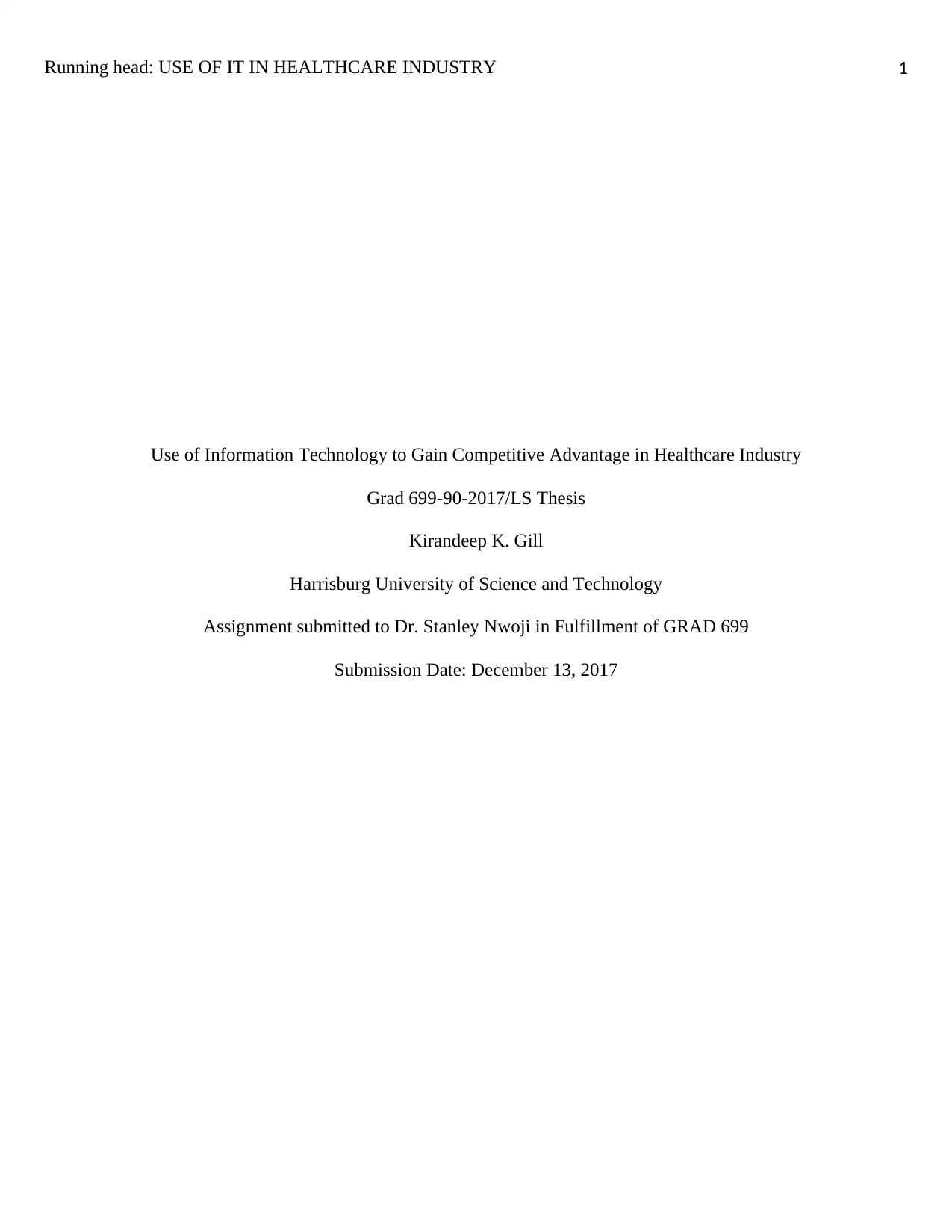
Running head: USE OF IT IN HEALTHCARE INDUSTRY
Use of Information Technology to Gain Competitive Advantage in Healthcare Industry
Grad 699-90-2017/LS Thesis
Kirandeep K. Gill
Harrisburg University of Science and Technology
Assignment submitted to Dr. Stanley Nwoji in Fulfillment of GRAD 699
Submission Date: December 13, 2017
1
Use of Information Technology to Gain Competitive Advantage in Healthcare Industry
Grad 699-90-2017/LS Thesis
Kirandeep K. Gill
Harrisburg University of Science and Technology
Assignment submitted to Dr. Stanley Nwoji in Fulfillment of GRAD 699
Submission Date: December 13, 2017
1
Paraphrase This Document
Need a fresh take? Get an instant paraphrase of this document with our AI Paraphraser
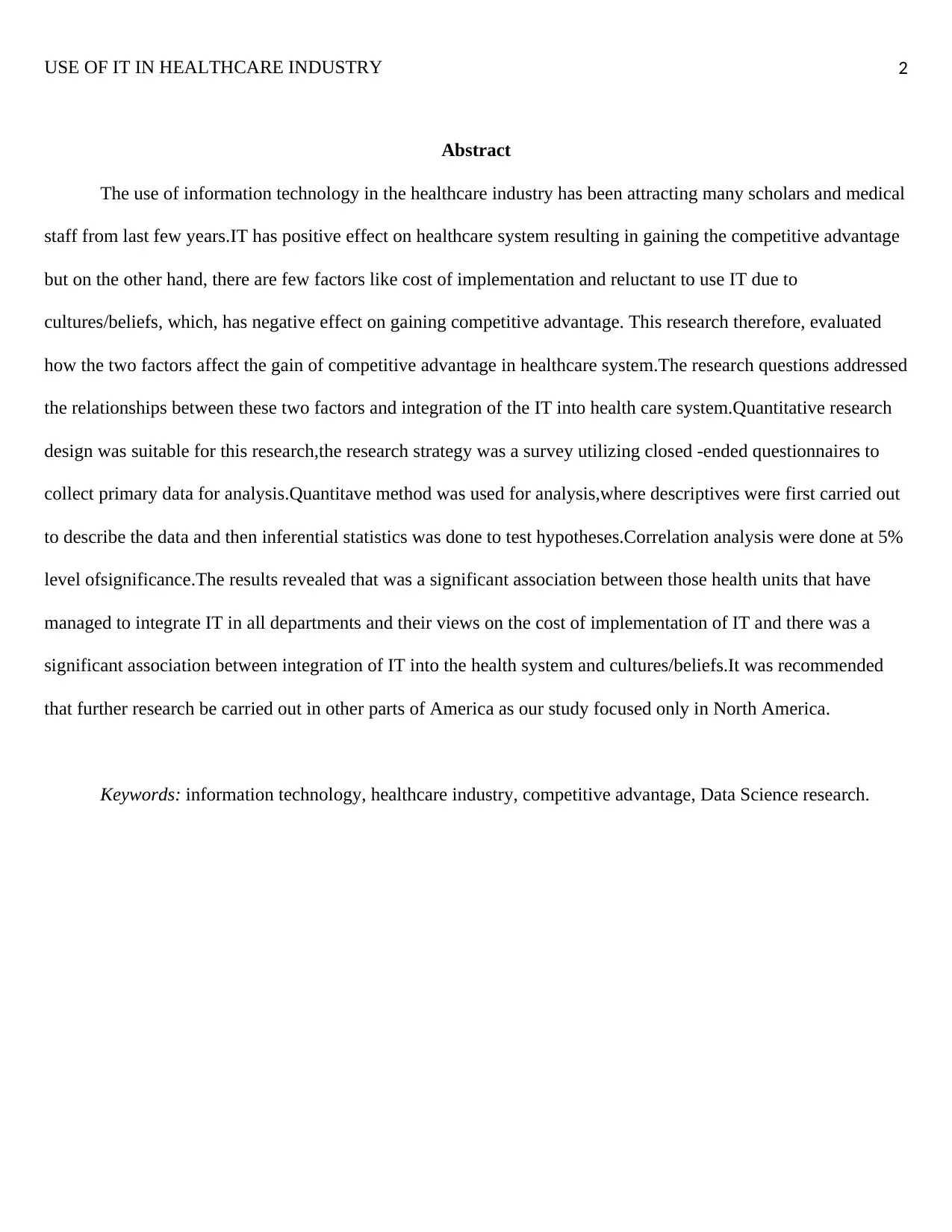
USE OF IT IN HEALTHCARE INDUSTRY
Abstract
The use of information technology in the healthcare industry has been attracting many scholars and medical
staff from last few years.IT has positive effect on healthcare system resulting in gaining the competitive advantage
but on the other hand, there are few factors like cost of implementation and reluctant to use IT due to
cultures/beliefs, which, has negative effect on gaining competitive advantage. This research therefore, evaluated
how the two factors affect the gain of competitive advantage in healthcare system.The research questions addressed
the relationships between these two factors and integration of the IT into health care system.Quantitative research
design was suitable for this research,the research strategy was a survey utilizing closed -ended questionnaires to
collect primary data for analysis.Quantitave method was used for analysis,where descriptives were first carried out
to describe the data and then inferential statistics was done to test hypotheses.Correlation analysis were done at 5%
level ofsignificance.The results revealed that was a significant association between those health units that have
managed to integrate IT in all departments and their views on the cost of implementation of IT and there was a
significant association between integration of IT into the health system and cultures/beliefs.It was recommended
that further research be carried out in other parts of America as our study focused only in North America.
Keywords: information technology, healthcare industry, competitive advantage, Data Science research.
2
Abstract
The use of information technology in the healthcare industry has been attracting many scholars and medical
staff from last few years.IT has positive effect on healthcare system resulting in gaining the competitive advantage
but on the other hand, there are few factors like cost of implementation and reluctant to use IT due to
cultures/beliefs, which, has negative effect on gaining competitive advantage. This research therefore, evaluated
how the two factors affect the gain of competitive advantage in healthcare system.The research questions addressed
the relationships between these two factors and integration of the IT into health care system.Quantitative research
design was suitable for this research,the research strategy was a survey utilizing closed -ended questionnaires to
collect primary data for analysis.Quantitave method was used for analysis,where descriptives were first carried out
to describe the data and then inferential statistics was done to test hypotheses.Correlation analysis were done at 5%
level ofsignificance.The results revealed that was a significant association between those health units that have
managed to integrate IT in all departments and their views on the cost of implementation of IT and there was a
significant association between integration of IT into the health system and cultures/beliefs.It was recommended
that further research be carried out in other parts of America as our study focused only in North America.
Keywords: information technology, healthcare industry, competitive advantage, Data Science research.
2
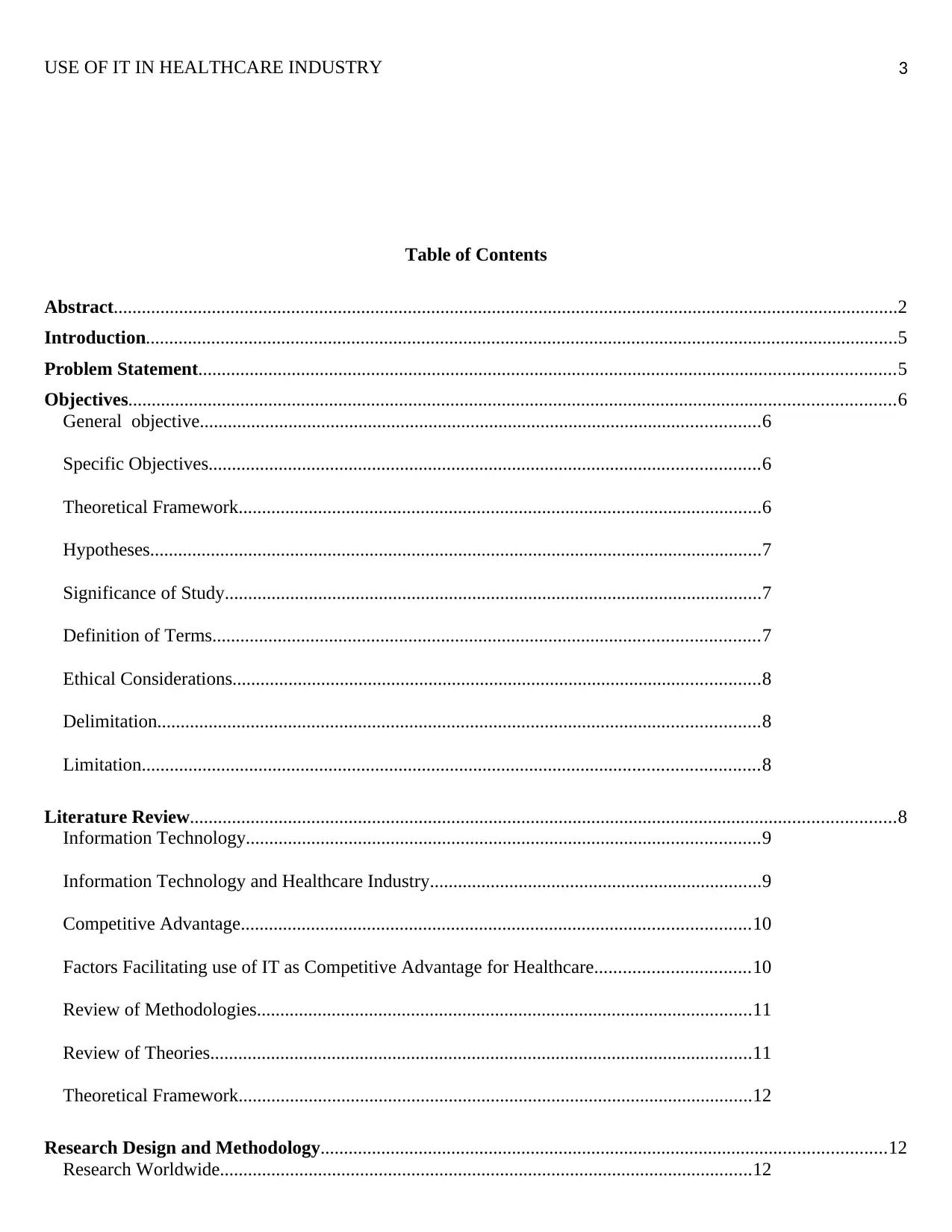
USE OF IT IN HEALTHCARE INDUSTRY
Table of Contents
Abstract........................................................................................................................................................................2
Introduction.................................................................................................................................................................5
Problem Statement.....................................................................................................................................................5
Objectives....................................................................................................................................................................6
General objective........................................................................................................................6
Specific Objectives......................................................................................................................6
Theoretical Framework................................................................................................................6
Hypotheses...................................................................................................................................7
Significance of Study...................................................................................................................7
Definition of Terms.....................................................................................................................7
Ethical Considerations.................................................................................................................8
Delimitation.................................................................................................................................8
Limitation....................................................................................................................................8
Literature Review.......................................................................................................................................................8
Information Technology..............................................................................................................9
Information Technology and Healthcare Industry.......................................................................9
Competitive Advantage.............................................................................................................10
Factors Facilitating use of IT as Competitive Advantage for Healthcare.................................10
Review of Methodologies..........................................................................................................11
Review of Theories....................................................................................................................11
Theoretical Framework..............................................................................................................12
Research Design and Methodology.........................................................................................................................12
Research Worldwide..................................................................................................................12
3
Table of Contents
Abstract........................................................................................................................................................................2
Introduction.................................................................................................................................................................5
Problem Statement.....................................................................................................................................................5
Objectives....................................................................................................................................................................6
General objective........................................................................................................................6
Specific Objectives......................................................................................................................6
Theoretical Framework................................................................................................................6
Hypotheses...................................................................................................................................7
Significance of Study...................................................................................................................7
Definition of Terms.....................................................................................................................7
Ethical Considerations.................................................................................................................8
Delimitation.................................................................................................................................8
Limitation....................................................................................................................................8
Literature Review.......................................................................................................................................................8
Information Technology..............................................................................................................9
Information Technology and Healthcare Industry.......................................................................9
Competitive Advantage.............................................................................................................10
Factors Facilitating use of IT as Competitive Advantage for Healthcare.................................10
Review of Methodologies..........................................................................................................11
Review of Theories....................................................................................................................11
Theoretical Framework..............................................................................................................12
Research Design and Methodology.........................................................................................................................12
Research Worldwide..................................................................................................................12
3
⊘ This is a preview!⊘
Do you want full access?
Subscribe today to unlock all pages.

Trusted by 1+ million students worldwide
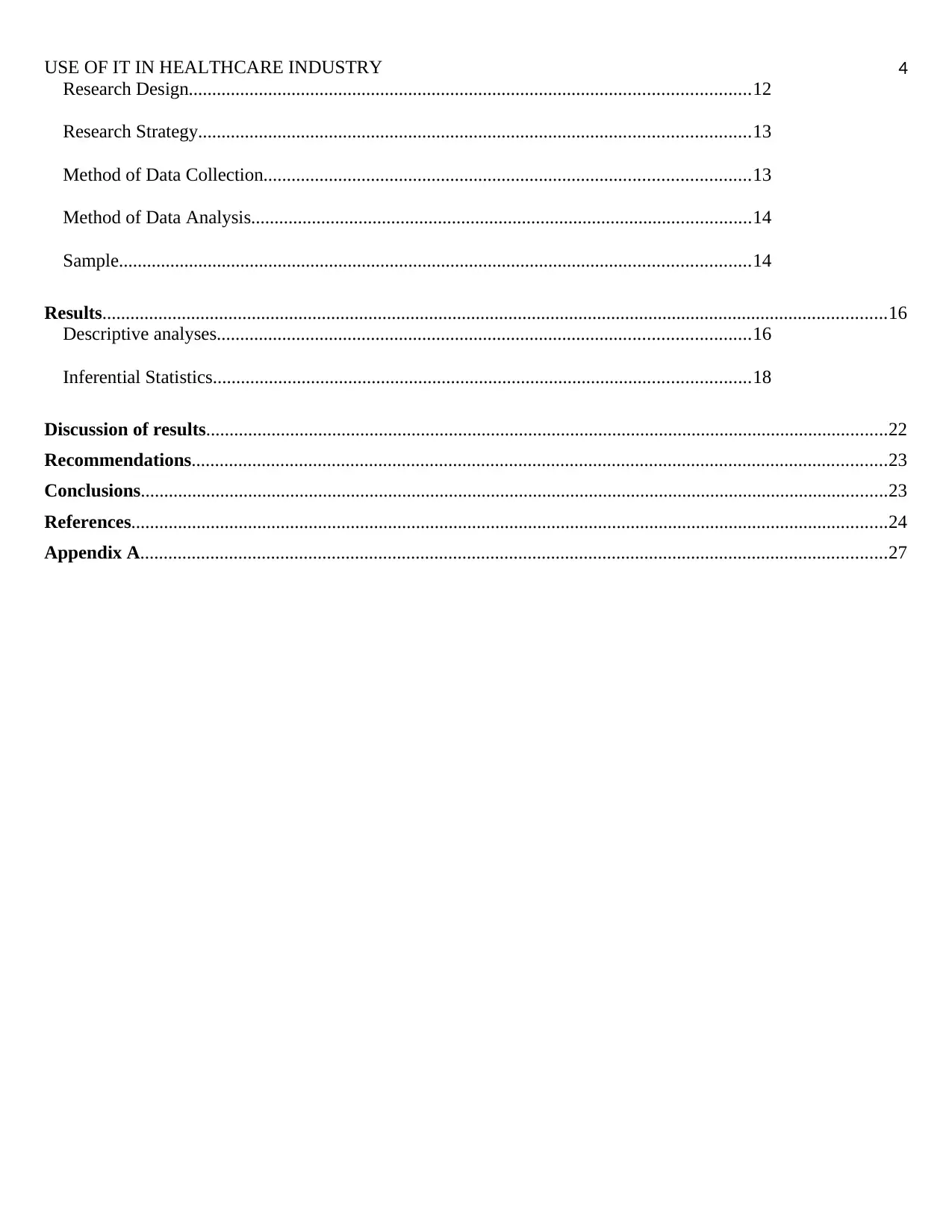
USE OF IT IN HEALTHCARE INDUSTRY
Research Design........................................................................................................................12
Research Strategy......................................................................................................................13
Method of Data Collection........................................................................................................13
Method of Data Analysis...........................................................................................................14
Sample.......................................................................................................................................14
Results........................................................................................................................................................................16
Descriptive analyses..................................................................................................................16
Inferential Statistics...................................................................................................................18
Discussion of results..................................................................................................................................................22
Recommendations.....................................................................................................................................................23
Conclusions................................................................................................................................................................23
References..................................................................................................................................................................24
Appendix A................................................................................................................................................................27
4
Research Design........................................................................................................................12
Research Strategy......................................................................................................................13
Method of Data Collection........................................................................................................13
Method of Data Analysis...........................................................................................................14
Sample.......................................................................................................................................14
Results........................................................................................................................................................................16
Descriptive analyses..................................................................................................................16
Inferential Statistics...................................................................................................................18
Discussion of results..................................................................................................................................................22
Recommendations.....................................................................................................................................................23
Conclusions................................................................................................................................................................23
References..................................................................................................................................................................24
Appendix A................................................................................................................................................................27
4
Paraphrase This Document
Need a fresh take? Get an instant paraphrase of this document with our AI Paraphraser
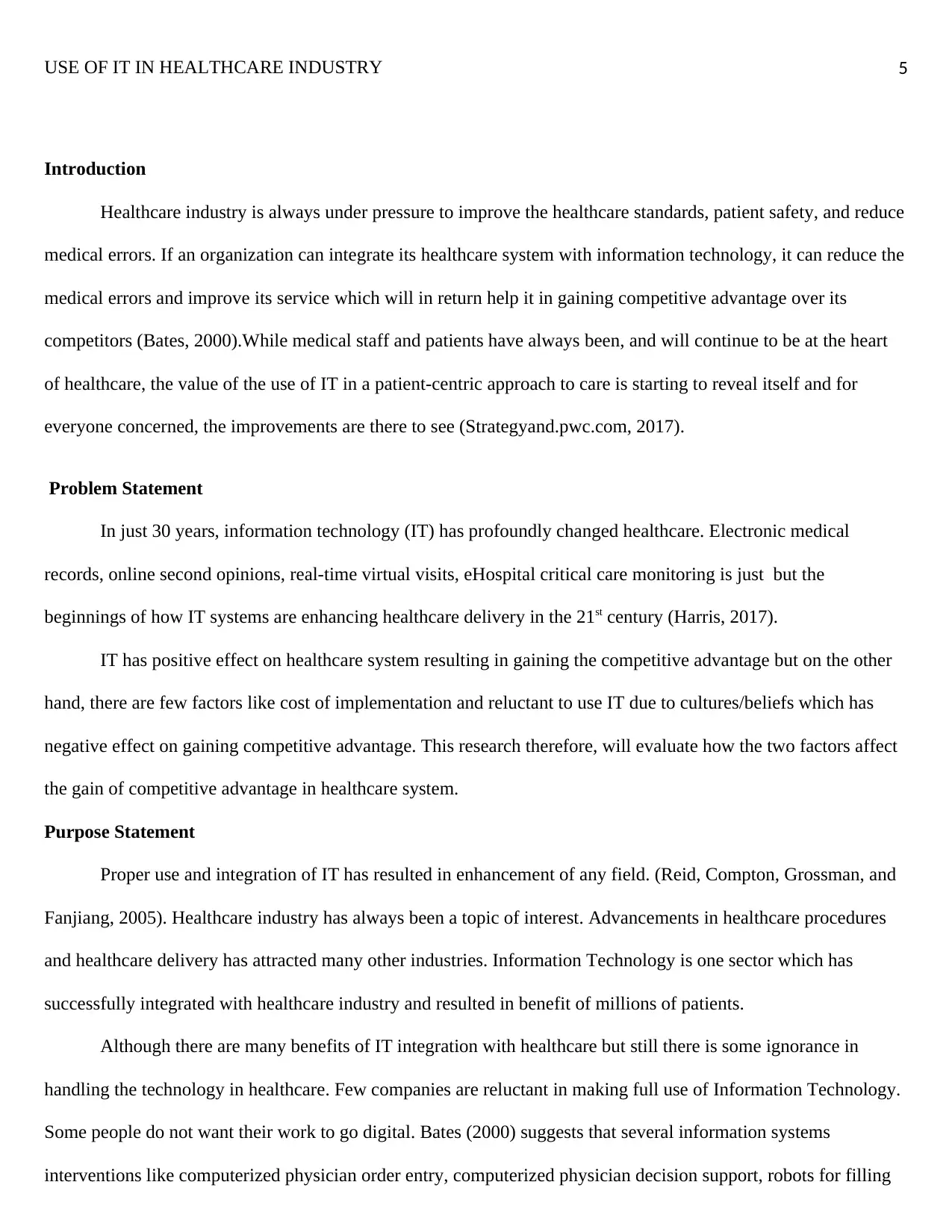
USE OF IT IN HEALTHCARE INDUSTRY
Introduction
Healthcare industry is always under pressure to improve the healthcare standards, patient safety, and reduce
medical errors. If an organization can integrate its healthcare system with information technology, it can reduce the
medical errors and improve its service which will in return help it in gaining competitive advantage over its
competitors (Bates, 2000).While medical staff and patients have always been, and will continue to be at the heart
of healthcare, the value of the use of IT in a patient-centric approach to care is starting to reveal itself and for
everyone concerned, the improvements are there to see (Strategyand.pwc.com, 2017).
Problem Statement
In just 30 years, information technology (IT) has profoundly changed healthcare. Electronic medical
records, online second opinions, real-time virtual visits, eHospital critical care monitoring is just but the
beginnings of how IT systems are enhancing healthcare delivery in the 21st century (Harris, 2017).
IT has positive effect on healthcare system resulting in gaining the competitive advantage but on the other
hand, there are few factors like cost of implementation and reluctant to use IT due to cultures/beliefs which has
negative effect on gaining competitive advantage. This research therefore, will evaluate how the two factors affect
the gain of competitive advantage in healthcare system.
Purpose Statement
Proper use and integration of IT has resulted in enhancement of any field. (Reid, Compton, Grossman, and
Fanjiang, 2005). Healthcare industry has always been a topic of interest. Advancements in healthcare procedures
and healthcare delivery has attracted many other industries. Information Technology is one sector which has
successfully integrated with healthcare industry and resulted in benefit of millions of patients.
Although there are many benefits of IT integration with healthcare but still there is some ignorance in
handling the technology in healthcare. Few companies are reluctant in making full use of Information Technology.
Some people do not want their work to go digital. Bates (2000) suggests that several information systems
interventions like computerized physician order entry, computerized physician decision support, robots for filling
5
Introduction
Healthcare industry is always under pressure to improve the healthcare standards, patient safety, and reduce
medical errors. If an organization can integrate its healthcare system with information technology, it can reduce the
medical errors and improve its service which will in return help it in gaining competitive advantage over its
competitors (Bates, 2000).While medical staff and patients have always been, and will continue to be at the heart
of healthcare, the value of the use of IT in a patient-centric approach to care is starting to reveal itself and for
everyone concerned, the improvements are there to see (Strategyand.pwc.com, 2017).
Problem Statement
In just 30 years, information technology (IT) has profoundly changed healthcare. Electronic medical
records, online second opinions, real-time virtual visits, eHospital critical care monitoring is just but the
beginnings of how IT systems are enhancing healthcare delivery in the 21st century (Harris, 2017).
IT has positive effect on healthcare system resulting in gaining the competitive advantage but on the other
hand, there are few factors like cost of implementation and reluctant to use IT due to cultures/beliefs which has
negative effect on gaining competitive advantage. This research therefore, will evaluate how the two factors affect
the gain of competitive advantage in healthcare system.
Purpose Statement
Proper use and integration of IT has resulted in enhancement of any field. (Reid, Compton, Grossman, and
Fanjiang, 2005). Healthcare industry has always been a topic of interest. Advancements in healthcare procedures
and healthcare delivery has attracted many other industries. Information Technology is one sector which has
successfully integrated with healthcare industry and resulted in benefit of millions of patients.
Although there are many benefits of IT integration with healthcare but still there is some ignorance in
handling the technology in healthcare. Few companies are reluctant in making full use of Information Technology.
Some people do not want their work to go digital. Bates (2000) suggests that several information systems
interventions like computerized physician order entry, computerized physician decision support, robots for filling
5
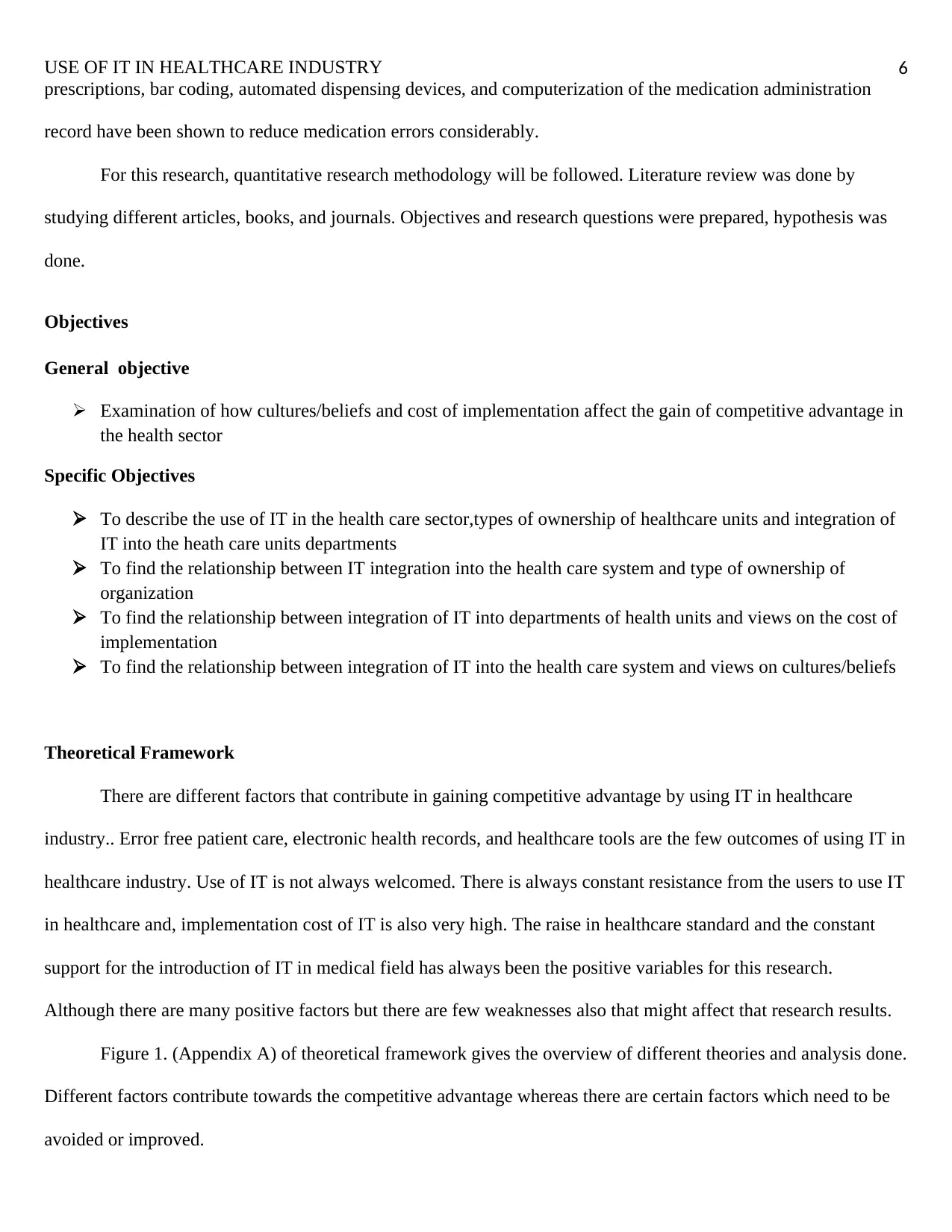
USE OF IT IN HEALTHCARE INDUSTRY
prescriptions, bar coding, automated dispensing devices, and computerization of the medication administration
record have been shown to reduce medication errors considerably.
For this research, quantitative research methodology will be followed. Literature review was done by
studying different articles, books, and journals. Objectives and research questions were prepared, hypothesis was
done.
Objectives
General objective
Examination of how cultures/beliefs and cost of implementation affect the gain of competitive advantage in
the health sector
Specific Objectives
To describe the use of IT in the health care sector,types of ownership of healthcare units and integration of
IT into the heath care units departments
To find the relationship between IT integration into the health care system and type of ownership of
organization
To find the relationship between integration of IT into departments of health units and views on the cost of
implementation
To find the relationship between integration of IT into the health care system and views on cultures/beliefs
Theoretical Framework
There are different factors that contribute in gaining competitive advantage by using IT in healthcare
industry.. Error free patient care, electronic health records, and healthcare tools are the few outcomes of using IT in
healthcare industry. Use of IT is not always welcomed. There is always constant resistance from the users to use IT
in healthcare and, implementation cost of IT is also very high. The raise in healthcare standard and the constant
support for the introduction of IT in medical field has always been the positive variables for this research.
Although there are many positive factors but there are few weaknesses also that might affect that research results.
Figure 1. (Appendix A) of theoretical framework gives the overview of different theories and analysis done.
Different factors contribute towards the competitive advantage whereas there are certain factors which need to be
avoided or improved.
6
prescriptions, bar coding, automated dispensing devices, and computerization of the medication administration
record have been shown to reduce medication errors considerably.
For this research, quantitative research methodology will be followed. Literature review was done by
studying different articles, books, and journals. Objectives and research questions were prepared, hypothesis was
done.
Objectives
General objective
Examination of how cultures/beliefs and cost of implementation affect the gain of competitive advantage in
the health sector
Specific Objectives
To describe the use of IT in the health care sector,types of ownership of healthcare units and integration of
IT into the heath care units departments
To find the relationship between IT integration into the health care system and type of ownership of
organization
To find the relationship between integration of IT into departments of health units and views on the cost of
implementation
To find the relationship between integration of IT into the health care system and views on cultures/beliefs
Theoretical Framework
There are different factors that contribute in gaining competitive advantage by using IT in healthcare
industry.. Error free patient care, electronic health records, and healthcare tools are the few outcomes of using IT in
healthcare industry. Use of IT is not always welcomed. There is always constant resistance from the users to use IT
in healthcare and, implementation cost of IT is also very high. The raise in healthcare standard and the constant
support for the introduction of IT in medical field has always been the positive variables for this research.
Although there are many positive factors but there are few weaknesses also that might affect that research results.
Figure 1. (Appendix A) of theoretical framework gives the overview of different theories and analysis done.
Different factors contribute towards the competitive advantage whereas there are certain factors which need to be
avoided or improved.
6
⊘ This is a preview!⊘
Do you want full access?
Subscribe today to unlock all pages.

Trusted by 1+ million students worldwide
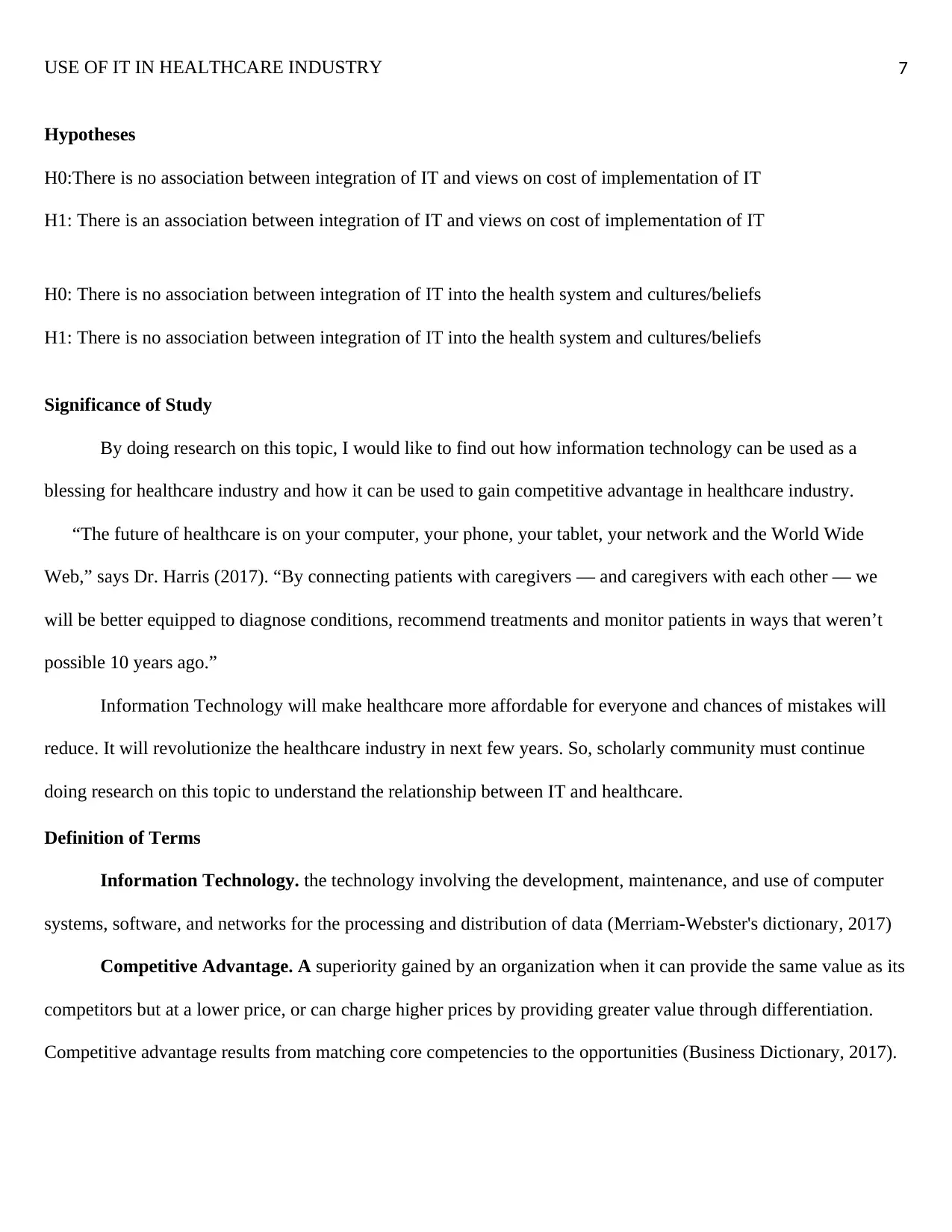
USE OF IT IN HEALTHCARE INDUSTRY
Hypotheses
H0:There is no association between integration of IT and views on cost of implementation of IT
H1: There is an association between integration of IT and views on cost of implementation of IT
H0: There is no association between integration of IT into the health system and cultures/beliefs
H1: There is no association between integration of IT into the health system and cultures/beliefs
Significance of Study
By doing research on this topic, I would like to find out how information technology can be used as a
blessing for healthcare industry and how it can be used to gain competitive advantage in healthcare industry.
“The future of healthcare is on your computer, your phone, your tablet, your network and the World Wide
Web,” says Dr. Harris (2017). “By connecting patients with caregivers ― and caregivers with each other ― we
will be better equipped to diagnose conditions, recommend treatments and monitor patients in ways that weren’t
possible 10 years ago.”
Information Technology will make healthcare more affordable for everyone and chances of mistakes will
reduce. It will revolutionize the healthcare industry in next few years. So, scholarly community must continue
doing research on this topic to understand the relationship between IT and healthcare.
Definition of Terms
Information Technology. the technology involving the development, maintenance, and use of computer
systems, software, and networks for the processing and distribution of data (Merriam-Webster's dictionary, 2017)
Competitive Advantage. A superiority gained by an organization when it can provide the same value as its
competitors but at a lower price, or can charge higher prices by providing greater value through differentiation.
Competitive advantage results from matching core competencies to the opportunities (Business Dictionary, 2017).
7
Hypotheses
H0:There is no association between integration of IT and views on cost of implementation of IT
H1: There is an association between integration of IT and views on cost of implementation of IT
H0: There is no association between integration of IT into the health system and cultures/beliefs
H1: There is no association between integration of IT into the health system and cultures/beliefs
Significance of Study
By doing research on this topic, I would like to find out how information technology can be used as a
blessing for healthcare industry and how it can be used to gain competitive advantage in healthcare industry.
“The future of healthcare is on your computer, your phone, your tablet, your network and the World Wide
Web,” says Dr. Harris (2017). “By connecting patients with caregivers ― and caregivers with each other ― we
will be better equipped to diagnose conditions, recommend treatments and monitor patients in ways that weren’t
possible 10 years ago.”
Information Technology will make healthcare more affordable for everyone and chances of mistakes will
reduce. It will revolutionize the healthcare industry in next few years. So, scholarly community must continue
doing research on this topic to understand the relationship between IT and healthcare.
Definition of Terms
Information Technology. the technology involving the development, maintenance, and use of computer
systems, software, and networks for the processing and distribution of data (Merriam-Webster's dictionary, 2017)
Competitive Advantage. A superiority gained by an organization when it can provide the same value as its
competitors but at a lower price, or can charge higher prices by providing greater value through differentiation.
Competitive advantage results from matching core competencies to the opportunities (Business Dictionary, 2017).
7
Paraphrase This Document
Need a fresh take? Get an instant paraphrase of this document with our AI Paraphraser
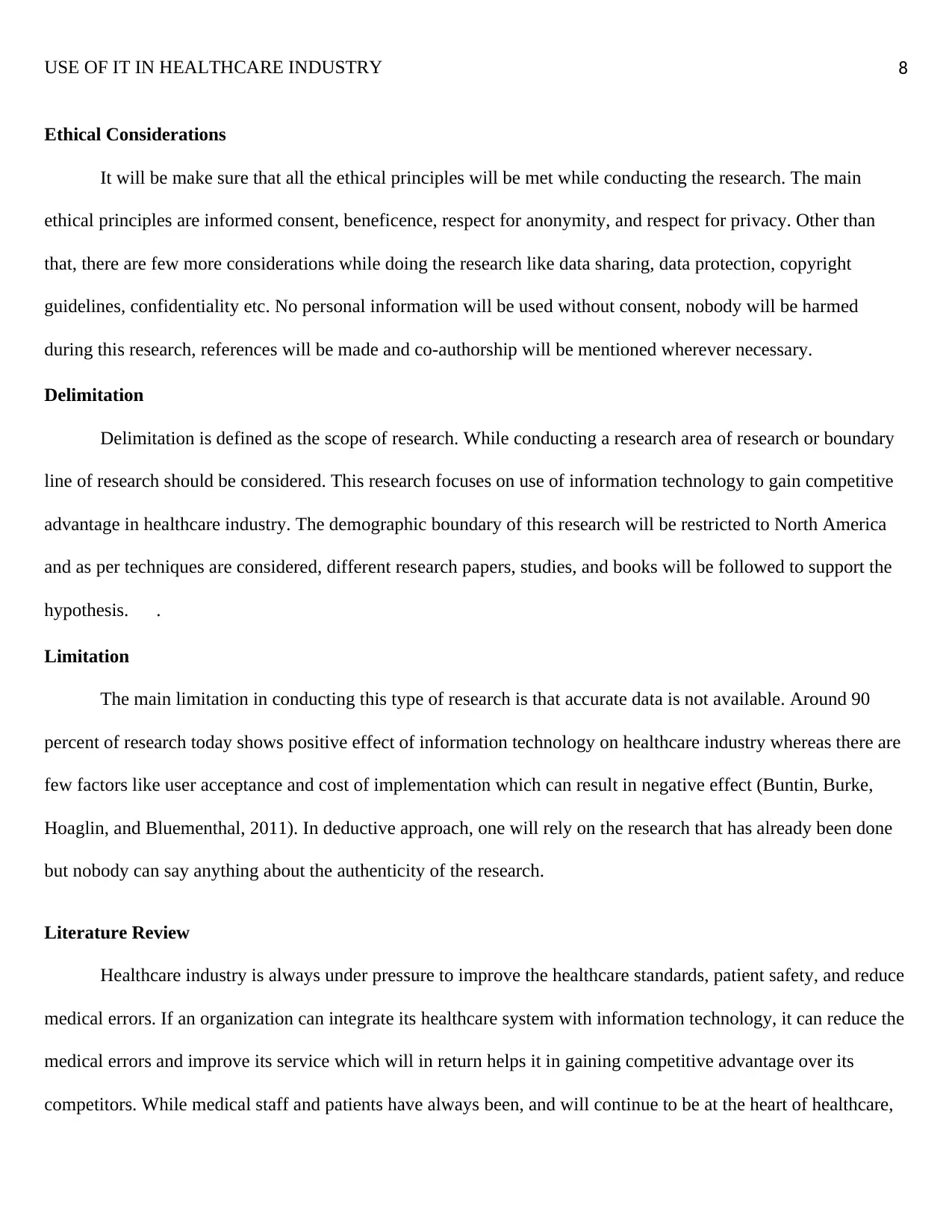
USE OF IT IN HEALTHCARE INDUSTRY
Ethical Considerations
It will be make sure that all the ethical principles will be met while conducting the research. The main
ethical principles are informed consent, beneficence, respect for anonymity, and respect for privacy. Other than
that, there are few more considerations while doing the research like data sharing, data protection, copyright
guidelines, confidentiality etc. No personal information will be used without consent, nobody will be harmed
during this research, references will be made and co-authorship will be mentioned wherever necessary.
Delimitation
Delimitation is defined as the scope of research. While conducting a research area of research or boundary
line of research should be considered. This research focuses on use of information technology to gain competitive
advantage in healthcare industry. The demographic boundary of this research will be restricted to North America
and as per techniques are considered, different research papers, studies, and books will be followed to support the
hypothesis. .
Limitation
The main limitation in conducting this type of research is that accurate data is not available. Around 90
percent of research today shows positive effect of information technology on healthcare industry whereas there are
few factors like user acceptance and cost of implementation which can result in negative effect (Buntin, Burke,
Hoaglin, and Bluementhal, 2011). In deductive approach, one will rely on the research that has already been done
but nobody can say anything about the authenticity of the research.
Literature Review
Healthcare industry is always under pressure to improve the healthcare standards, patient safety, and reduce
medical errors. If an organization can integrate its healthcare system with information technology, it can reduce the
medical errors and improve its service which will in return helps it in gaining competitive advantage over its
competitors. While medical staff and patients have always been, and will continue to be at the heart of healthcare,
8
Ethical Considerations
It will be make sure that all the ethical principles will be met while conducting the research. The main
ethical principles are informed consent, beneficence, respect for anonymity, and respect for privacy. Other than
that, there are few more considerations while doing the research like data sharing, data protection, copyright
guidelines, confidentiality etc. No personal information will be used without consent, nobody will be harmed
during this research, references will be made and co-authorship will be mentioned wherever necessary.
Delimitation
Delimitation is defined as the scope of research. While conducting a research area of research or boundary
line of research should be considered. This research focuses on use of information technology to gain competitive
advantage in healthcare industry. The demographic boundary of this research will be restricted to North America
and as per techniques are considered, different research papers, studies, and books will be followed to support the
hypothesis. .
Limitation
The main limitation in conducting this type of research is that accurate data is not available. Around 90
percent of research today shows positive effect of information technology on healthcare industry whereas there are
few factors like user acceptance and cost of implementation which can result in negative effect (Buntin, Burke,
Hoaglin, and Bluementhal, 2011). In deductive approach, one will rely on the research that has already been done
but nobody can say anything about the authenticity of the research.
Literature Review
Healthcare industry is always under pressure to improve the healthcare standards, patient safety, and reduce
medical errors. If an organization can integrate its healthcare system with information technology, it can reduce the
medical errors and improve its service which will in return helps it in gaining competitive advantage over its
competitors. While medical staff and patients have always been, and will continue to be at the heart of healthcare,
8
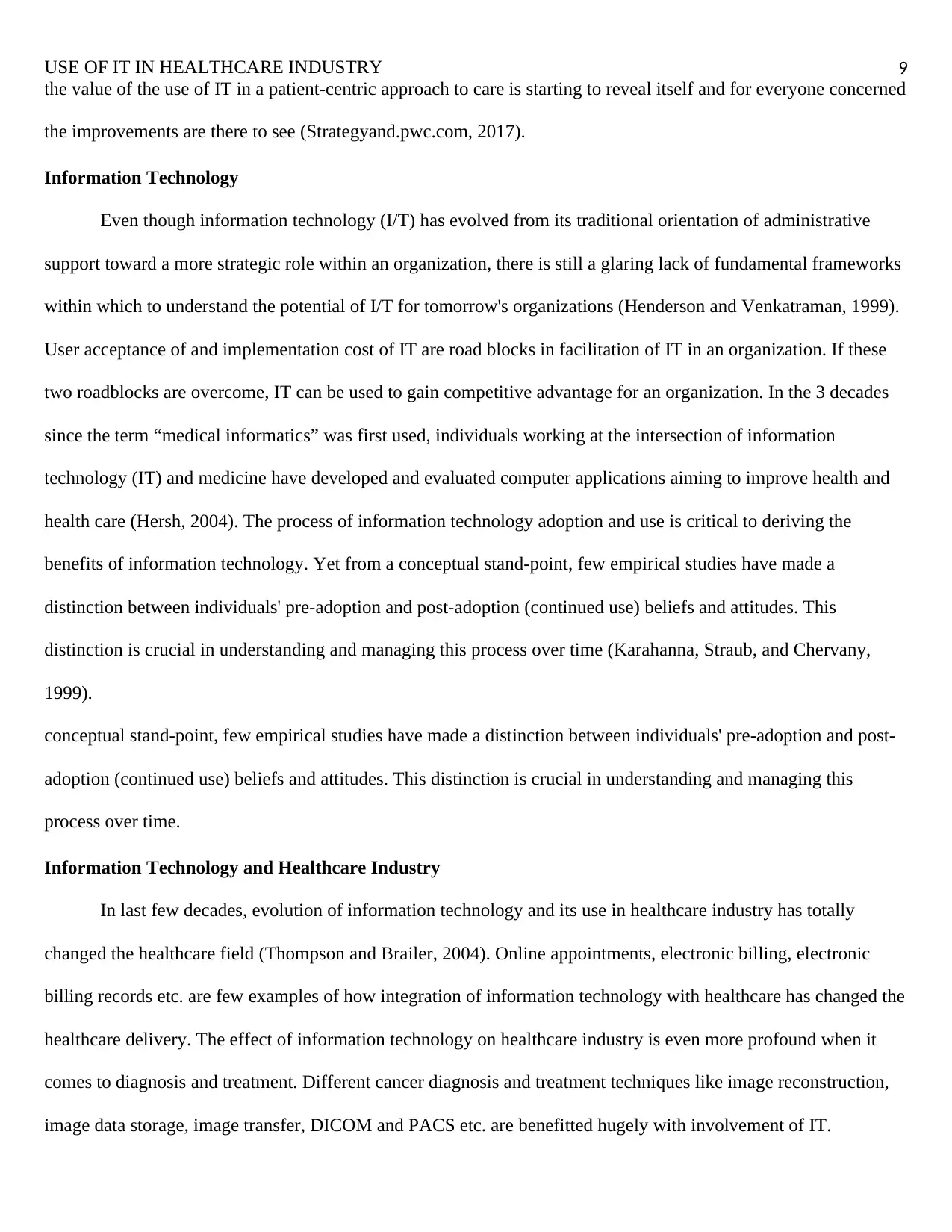
USE OF IT IN HEALTHCARE INDUSTRY
the value of the use of IT in a patient-centric approach to care is starting to reveal itself and for everyone concerned
the improvements are there to see (Strategyand.pwc.com, 2017).
Information Technology
Even though information technology (I/T) has evolved from its traditional orientation of administrative
support toward a more strategic role within an organization, there is still a glaring lack of fundamental frameworks
within which to understand the potential of I/T for tomorrow's organizations (Henderson and Venkatraman, 1999).
User acceptance of and implementation cost of IT are road blocks in facilitation of IT in an organization. If these
two roadblocks are overcome, IT can be used to gain competitive advantage for an organization. In the 3 decades
since the term “medical informatics” was first used, individuals working at the intersection of information
technology (IT) and medicine have developed and evaluated computer applications aiming to improve health and
health care (Hersh, 2004). The process of information technology adoption and use is critical to deriving the
benefits of information technology. Yet from a conceptual stand-point, few empirical studies have made a
distinction between individuals' pre-adoption and post-adoption (continued use) beliefs and attitudes. This
distinction is crucial in understanding and managing this process over time (Karahanna, Straub, and Chervany,
1999).
conceptual stand-point, few empirical studies have made a distinction between individuals' pre-adoption and post-
adoption (continued use) beliefs and attitudes. This distinction is crucial in understanding and managing this
process over time.
Information Technology and Healthcare Industry
In last few decades, evolution of information technology and its use in healthcare industry has totally
changed the healthcare field (Thompson and Brailer, 2004). Online appointments, electronic billing, electronic
billing records etc. are few examples of how integration of information technology with healthcare has changed the
healthcare delivery. The effect of information technology on healthcare industry is even more profound when it
comes to diagnosis and treatment. Different cancer diagnosis and treatment techniques like image reconstruction,
image data storage, image transfer, DICOM and PACS etc. are benefitted hugely with involvement of IT.
9
the value of the use of IT in a patient-centric approach to care is starting to reveal itself and for everyone concerned
the improvements are there to see (Strategyand.pwc.com, 2017).
Information Technology
Even though information technology (I/T) has evolved from its traditional orientation of administrative
support toward a more strategic role within an organization, there is still a glaring lack of fundamental frameworks
within which to understand the potential of I/T for tomorrow's organizations (Henderson and Venkatraman, 1999).
User acceptance of and implementation cost of IT are road blocks in facilitation of IT in an organization. If these
two roadblocks are overcome, IT can be used to gain competitive advantage for an organization. In the 3 decades
since the term “medical informatics” was first used, individuals working at the intersection of information
technology (IT) and medicine have developed and evaluated computer applications aiming to improve health and
health care (Hersh, 2004). The process of information technology adoption and use is critical to deriving the
benefits of information technology. Yet from a conceptual stand-point, few empirical studies have made a
distinction between individuals' pre-adoption and post-adoption (continued use) beliefs and attitudes. This
distinction is crucial in understanding and managing this process over time (Karahanna, Straub, and Chervany,
1999).
conceptual stand-point, few empirical studies have made a distinction between individuals' pre-adoption and post-
adoption (continued use) beliefs and attitudes. This distinction is crucial in understanding and managing this
process over time.
Information Technology and Healthcare Industry
In last few decades, evolution of information technology and its use in healthcare industry has totally
changed the healthcare field (Thompson and Brailer, 2004). Online appointments, electronic billing, electronic
billing records etc. are few examples of how integration of information technology with healthcare has changed the
healthcare delivery. The effect of information technology on healthcare industry is even more profound when it
comes to diagnosis and treatment. Different cancer diagnosis and treatment techniques like image reconstruction,
image data storage, image transfer, DICOM and PACS etc. are benefitted hugely with involvement of IT.
9
⊘ This is a preview!⊘
Do you want full access?
Subscribe today to unlock all pages.

Trusted by 1+ million students worldwide
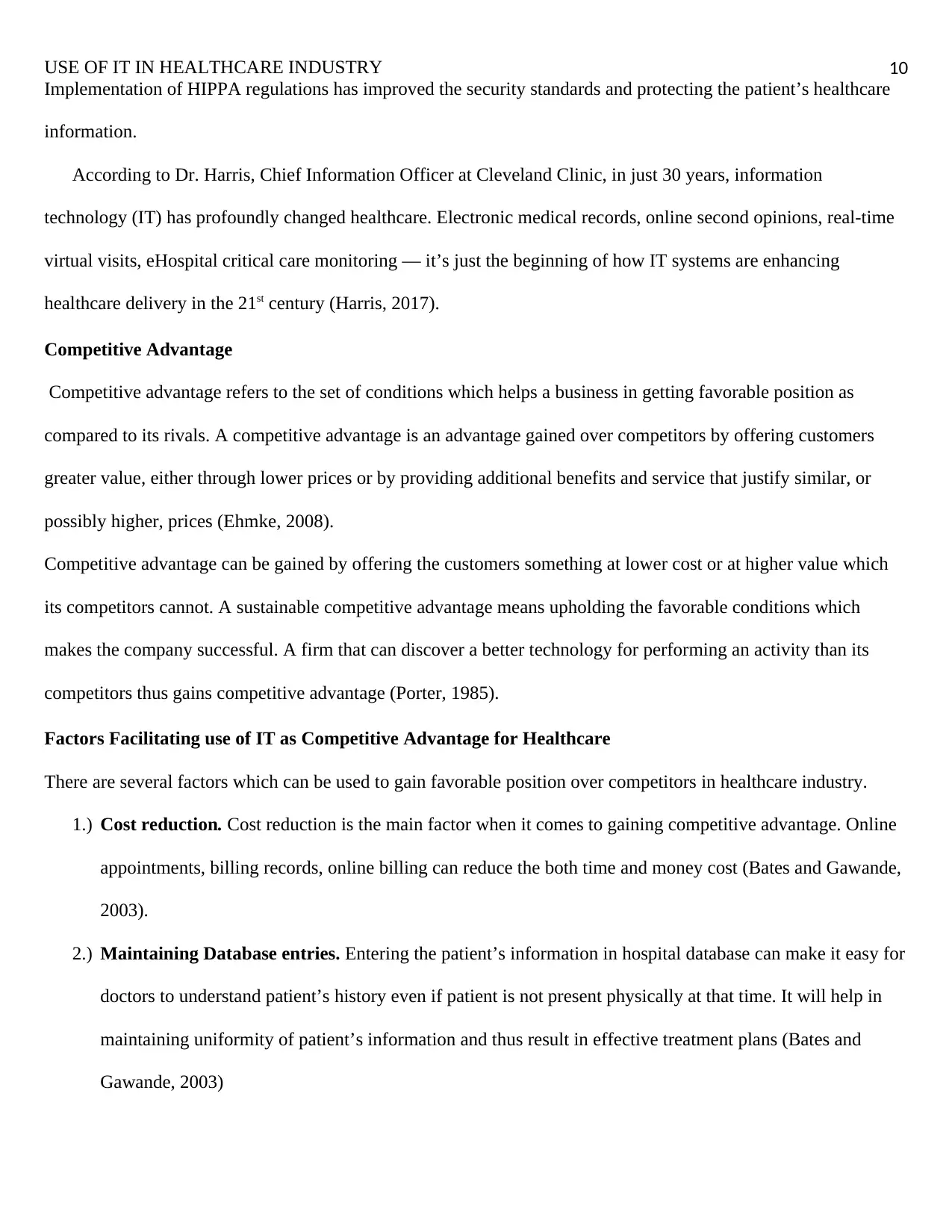
USE OF IT IN HEALTHCARE INDUSTRY
Implementation of HIPPA regulations has improved the security standards and protecting the patient’s healthcare
information.
According to Dr. Harris, Chief Information Officer at Cleveland Clinic, in just 30 years, information
technology (IT) has profoundly changed healthcare. Electronic medical records, online second opinions, real-time
virtual visits, eHospital critical care monitoring — it’s just the beginning of how IT systems are enhancing
healthcare delivery in the 21st century (Harris, 2017).
Competitive Advantage
Competitive advantage refers to the set of conditions which helps a business in getting favorable position as
compared to its rivals. A competitive advantage is an advantage gained over competitors by offering customers
greater value, either through lower prices or by providing additional benefits and service that justify similar, or
possibly higher, prices (Ehmke, 2008).
Competitive advantage can be gained by offering the customers something at lower cost or at higher value which
its competitors cannot. A sustainable competitive advantage means upholding the favorable conditions which
makes the company successful. A firm that can discover a better technology for performing an activity than its
competitors thus gains competitive advantage (Porter, 1985).
Factors Facilitating use of IT as Competitive Advantage for Healthcare
There are several factors which can be used to gain favorable position over competitors in healthcare industry.
1.) Cost reduction. Cost reduction is the main factor when it comes to gaining competitive advantage. Online
appointments, billing records, online billing can reduce the both time and money cost (Bates and Gawande,
2003).
2.) Maintaining Database entries. Entering the patient’s information in hospital database can make it easy for
doctors to understand patient’s history even if patient is not present physically at that time. It will help in
maintaining uniformity of patient’s information and thus result in effective treatment plans (Bates and
Gawande, 2003)
10
Implementation of HIPPA regulations has improved the security standards and protecting the patient’s healthcare
information.
According to Dr. Harris, Chief Information Officer at Cleveland Clinic, in just 30 years, information
technology (IT) has profoundly changed healthcare. Electronic medical records, online second opinions, real-time
virtual visits, eHospital critical care monitoring — it’s just the beginning of how IT systems are enhancing
healthcare delivery in the 21st century (Harris, 2017).
Competitive Advantage
Competitive advantage refers to the set of conditions which helps a business in getting favorable position as
compared to its rivals. A competitive advantage is an advantage gained over competitors by offering customers
greater value, either through lower prices or by providing additional benefits and service that justify similar, or
possibly higher, prices (Ehmke, 2008).
Competitive advantage can be gained by offering the customers something at lower cost or at higher value which
its competitors cannot. A sustainable competitive advantage means upholding the favorable conditions which
makes the company successful. A firm that can discover a better technology for performing an activity than its
competitors thus gains competitive advantage (Porter, 1985).
Factors Facilitating use of IT as Competitive Advantage for Healthcare
There are several factors which can be used to gain favorable position over competitors in healthcare industry.
1.) Cost reduction. Cost reduction is the main factor when it comes to gaining competitive advantage. Online
appointments, billing records, online billing can reduce the both time and money cost (Bates and Gawande,
2003).
2.) Maintaining Database entries. Entering the patient’s information in hospital database can make it easy for
doctors to understand patient’s history even if patient is not present physically at that time. It will help in
maintaining uniformity of patient’s information and thus result in effective treatment plans (Bates and
Gawande, 2003)
10
Paraphrase This Document
Need a fresh take? Get an instant paraphrase of this document with our AI Paraphraser
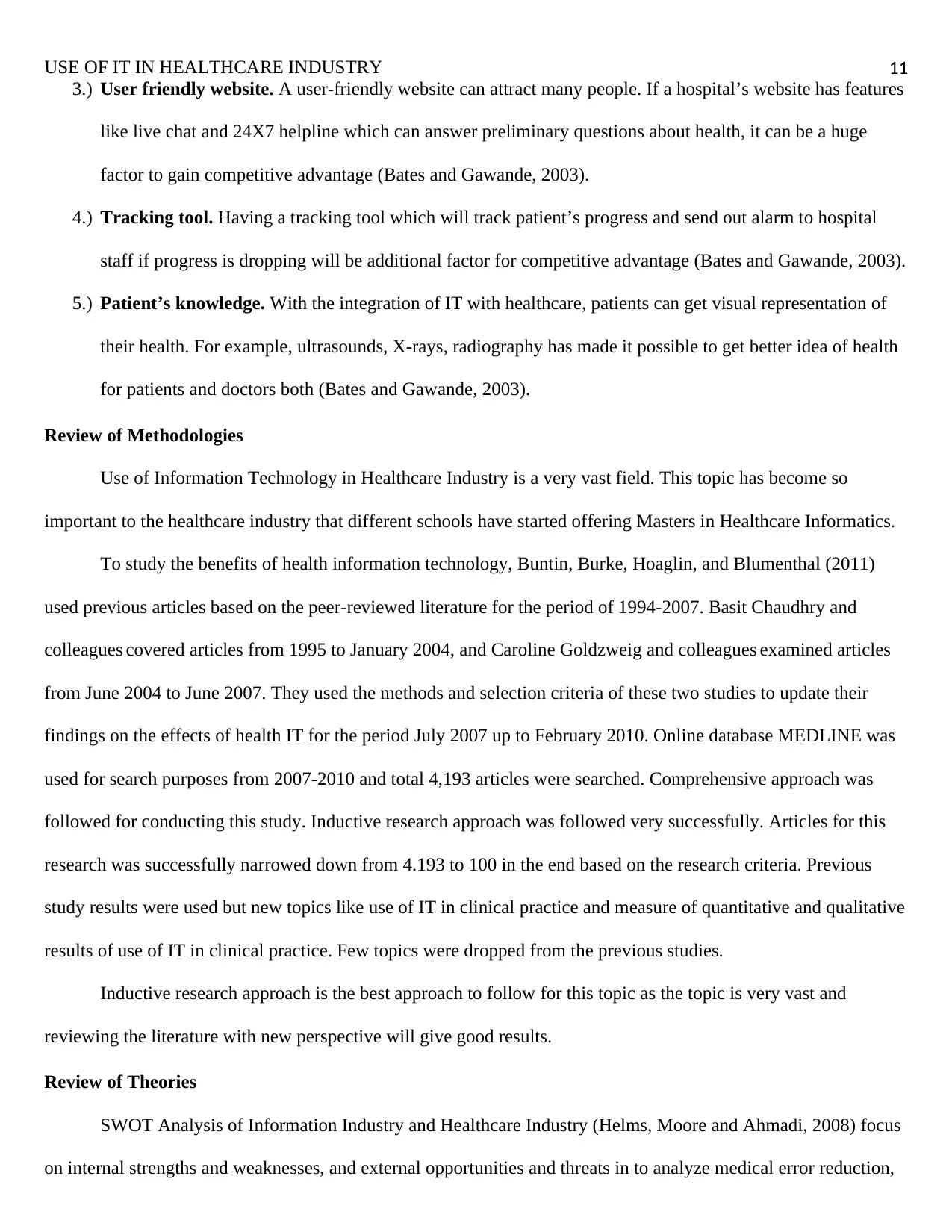
USE OF IT IN HEALTHCARE INDUSTRY
3.) User friendly website. A user-friendly website can attract many people. If a hospital’s website has features
like live chat and 24X7 helpline which can answer preliminary questions about health, it can be a huge
factor to gain competitive advantage (Bates and Gawande, 2003).
4.) Tracking tool. Having a tracking tool which will track patient’s progress and send out alarm to hospital
staff if progress is dropping will be additional factor for competitive advantage (Bates and Gawande, 2003).
5.) Patient’s knowledge. With the integration of IT with healthcare, patients can get visual representation of
their health. For example, ultrasounds, X-rays, radiography has made it possible to get better idea of health
for patients and doctors both (Bates and Gawande, 2003).
Review of Methodologies
Use of Information Technology in Healthcare Industry is a very vast field. This topic has become so
important to the healthcare industry that different schools have started offering Masters in Healthcare Informatics.
To study the benefits of health information technology, Buntin, Burke, Hoaglin, and Blumenthal (2011)
used previous articles based on the peer-reviewed literature for the period of 1994-2007. Basit Chaudhry and
colleagues covered articles from 1995 to January 2004, and Caroline Goldzweig and colleagues examined articles
from June 2004 to June 2007. They used the methods and selection criteria of these two studies to update their
findings on the effects of health IT for the period July 2007 up to February 2010. Online database MEDLINE was
used for search purposes from 2007-2010 and total 4,193 articles were searched. Comprehensive approach was
followed for conducting this study. Inductive research approach was followed very successfully. Articles for this
research was successfully narrowed down from 4.193 to 100 in the end based on the research criteria. Previous
study results were used but new topics like use of IT in clinical practice and measure of quantitative and qualitative
results of use of IT in clinical practice. Few topics were dropped from the previous studies.
Inductive research approach is the best approach to follow for this topic as the topic is very vast and
reviewing the literature with new perspective will give good results.
Review of Theories
SWOT Analysis of Information Industry and Healthcare Industry (Helms, Moore and Ahmadi, 2008) focus
on internal strengths and weaknesses, and external opportunities and threats in to analyze medical error reduction,
11
3.) User friendly website. A user-friendly website can attract many people. If a hospital’s website has features
like live chat and 24X7 helpline which can answer preliminary questions about health, it can be a huge
factor to gain competitive advantage (Bates and Gawande, 2003).
4.) Tracking tool. Having a tracking tool which will track patient’s progress and send out alarm to hospital
staff if progress is dropping will be additional factor for competitive advantage (Bates and Gawande, 2003).
5.) Patient’s knowledge. With the integration of IT with healthcare, patients can get visual representation of
their health. For example, ultrasounds, X-rays, radiography has made it possible to get better idea of health
for patients and doctors both (Bates and Gawande, 2003).
Review of Methodologies
Use of Information Technology in Healthcare Industry is a very vast field. This topic has become so
important to the healthcare industry that different schools have started offering Masters in Healthcare Informatics.
To study the benefits of health information technology, Buntin, Burke, Hoaglin, and Blumenthal (2011)
used previous articles based on the peer-reviewed literature for the period of 1994-2007. Basit Chaudhry and
colleagues covered articles from 1995 to January 2004, and Caroline Goldzweig and colleagues examined articles
from June 2004 to June 2007. They used the methods and selection criteria of these two studies to update their
findings on the effects of health IT for the period July 2007 up to February 2010. Online database MEDLINE was
used for search purposes from 2007-2010 and total 4,193 articles were searched. Comprehensive approach was
followed for conducting this study. Inductive research approach was followed very successfully. Articles for this
research was successfully narrowed down from 4.193 to 100 in the end based on the research criteria. Previous
study results were used but new topics like use of IT in clinical practice and measure of quantitative and qualitative
results of use of IT in clinical practice. Few topics were dropped from the previous studies.
Inductive research approach is the best approach to follow for this topic as the topic is very vast and
reviewing the literature with new perspective will give good results.
Review of Theories
SWOT Analysis of Information Industry and Healthcare Industry (Helms, Moore and Ahmadi, 2008) focus
on internal strengths and weaknesses, and external opportunities and threats in to analyze medical error reduction,
11
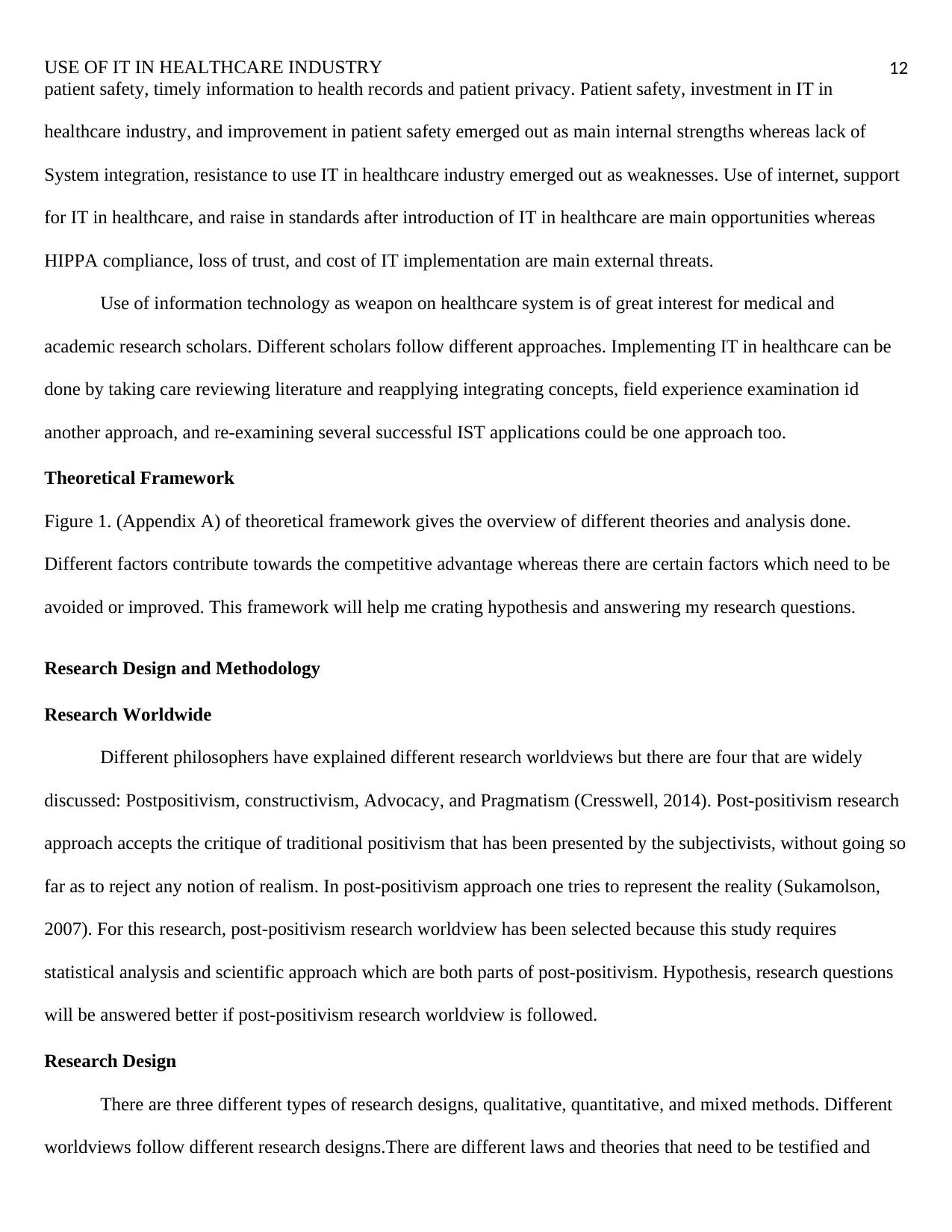
USE OF IT IN HEALTHCARE INDUSTRY
patient safety, timely information to health records and patient privacy. Patient safety, investment in IT in
healthcare industry, and improvement in patient safety emerged out as main internal strengths whereas lack of
System integration, resistance to use IT in healthcare industry emerged out as weaknesses. Use of internet, support
for IT in healthcare, and raise in standards after introduction of IT in healthcare are main opportunities whereas
HIPPA compliance, loss of trust, and cost of IT implementation are main external threats.
Use of information technology as weapon on healthcare system is of great interest for medical and
academic research scholars. Different scholars follow different approaches. Implementing IT in healthcare can be
done by taking care reviewing literature and reapplying integrating concepts, field experience examination id
another approach, and re-examining several successful IST applications could be one approach too.
Theoretical Framework
Figure 1. (Appendix A) of theoretical framework gives the overview of different theories and analysis done.
Different factors contribute towards the competitive advantage whereas there are certain factors which need to be
avoided or improved. This framework will help me crating hypothesis and answering my research questions.
Research Design and Methodology
Research Worldwide
Different philosophers have explained different research worldviews but there are four that are widely
discussed: Postpositivism, constructivism, Advocacy, and Pragmatism (Cresswell, 2014). Post-positivism research
approach accepts the critique of traditional positivism that has been presented by the subjectivists, without going so
far as to reject any notion of realism. In post-positivism approach one tries to represent the reality (Sukamolson,
2007). For this research, post-positivism research worldview has been selected because this study requires
statistical analysis and scientific approach which are both parts of post-positivism. Hypothesis, research questions
will be answered better if post-positivism research worldview is followed.
Research Design
There are three different types of research designs, qualitative, quantitative, and mixed methods. Different
worldviews follow different research designs.There are different laws and theories that need to be testified and
12
patient safety, timely information to health records and patient privacy. Patient safety, investment in IT in
healthcare industry, and improvement in patient safety emerged out as main internal strengths whereas lack of
System integration, resistance to use IT in healthcare industry emerged out as weaknesses. Use of internet, support
for IT in healthcare, and raise in standards after introduction of IT in healthcare are main opportunities whereas
HIPPA compliance, loss of trust, and cost of IT implementation are main external threats.
Use of information technology as weapon on healthcare system is of great interest for medical and
academic research scholars. Different scholars follow different approaches. Implementing IT in healthcare can be
done by taking care reviewing literature and reapplying integrating concepts, field experience examination id
another approach, and re-examining several successful IST applications could be one approach too.
Theoretical Framework
Figure 1. (Appendix A) of theoretical framework gives the overview of different theories and analysis done.
Different factors contribute towards the competitive advantage whereas there are certain factors which need to be
avoided or improved. This framework will help me crating hypothesis and answering my research questions.
Research Design and Methodology
Research Worldwide
Different philosophers have explained different research worldviews but there are four that are widely
discussed: Postpositivism, constructivism, Advocacy, and Pragmatism (Cresswell, 2014). Post-positivism research
approach accepts the critique of traditional positivism that has been presented by the subjectivists, without going so
far as to reject any notion of realism. In post-positivism approach one tries to represent the reality (Sukamolson,
2007). For this research, post-positivism research worldview has been selected because this study requires
statistical analysis and scientific approach which are both parts of post-positivism. Hypothesis, research questions
will be answered better if post-positivism research worldview is followed.
Research Design
There are three different types of research designs, qualitative, quantitative, and mixed methods. Different
worldviews follow different research designs.There are different laws and theories that need to be testified and
12
⊘ This is a preview!⊘
Do you want full access?
Subscribe today to unlock all pages.

Trusted by 1+ million students worldwide
1 out of 27
Related Documents
Your All-in-One AI-Powered Toolkit for Academic Success.
+13062052269
info@desklib.com
Available 24*7 on WhatsApp / Email
![[object Object]](/_next/static/media/star-bottom.7253800d.svg)
Unlock your academic potential
Copyright © 2020–2025 A2Z Services. All Rights Reserved. Developed and managed by ZUCOL.





